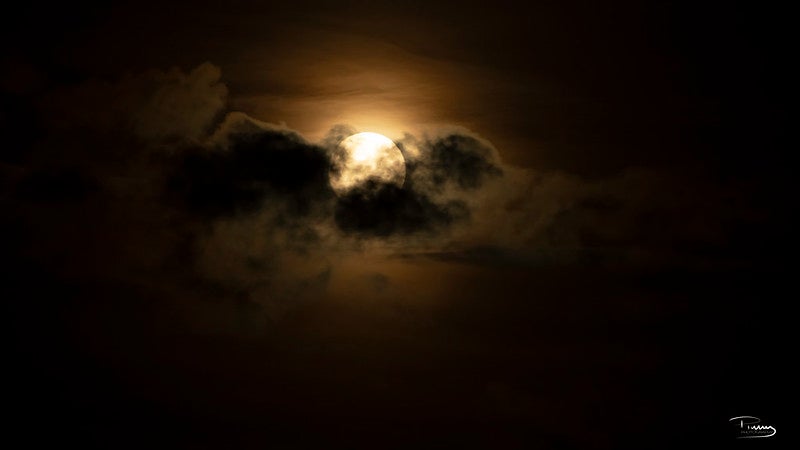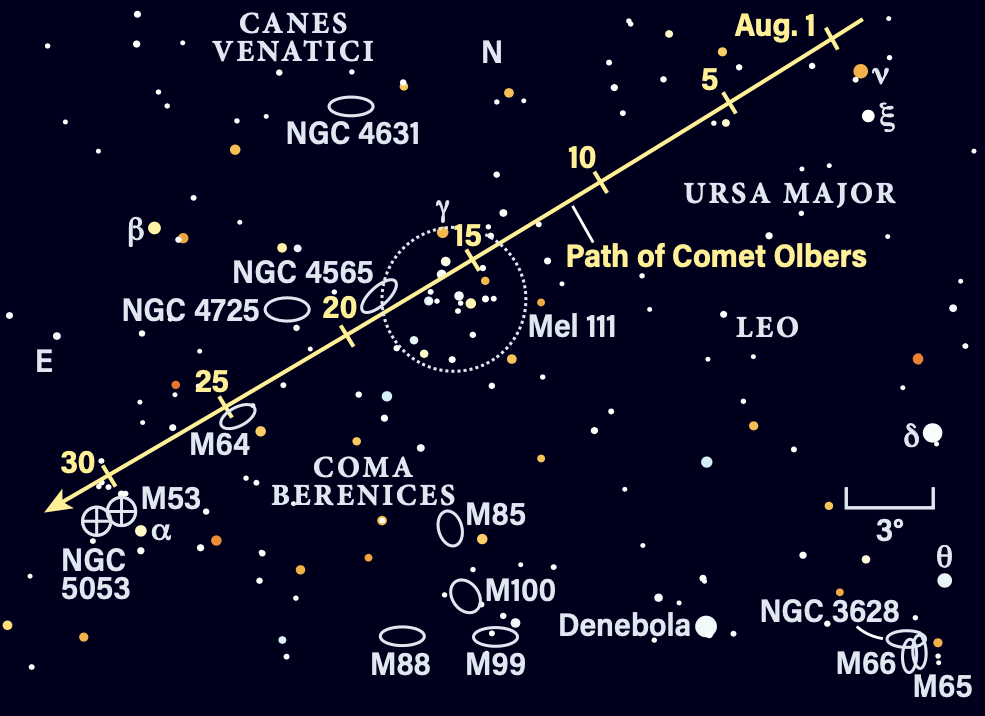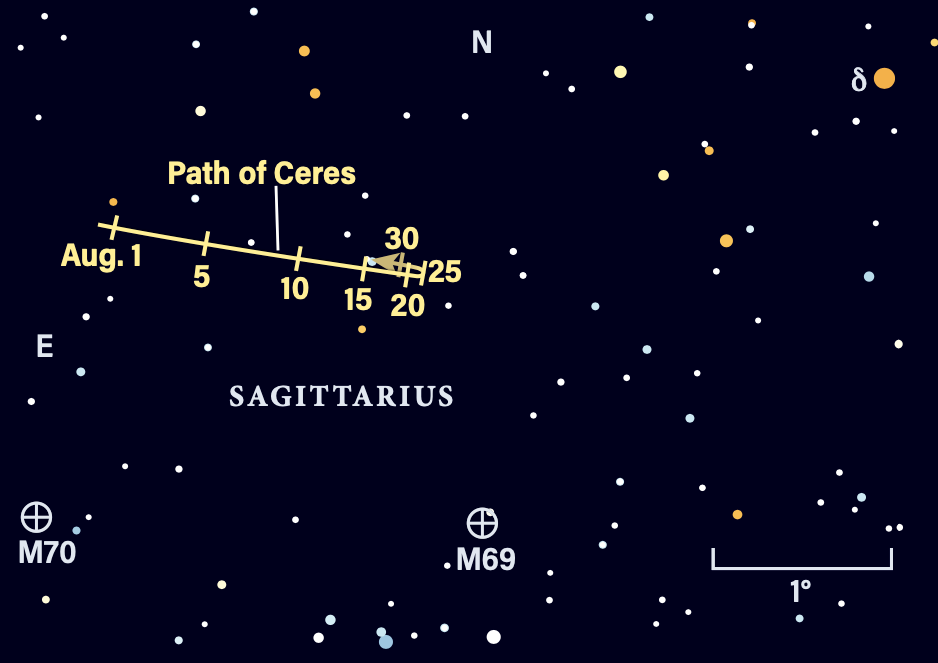
Friday, August 16
Saturn is where all the action is at this evening, as the planet’s brightest moon, Titan, slips beneath Saturn’s south pole. The planet rises around 9 P.M. local daylight time and stands more than 20° high within two hours. Glowing at magnitude 0.7, the ringed planet is relatively easy to spot in Aquarius, as it outshines the constellation’s stars. You can find it to the right of the Circlet asterism in Pisces as this region of sky is rising.
Once you can spot it in your telescope, look just south of the disk to locate Titan, moving from east to west and standing roughly due south of Saturn at 12:30 A.M. EDT (on the 17th in the Eastern time zone only, late on the 16th for those farther west). The moon stands a scant 1″ beneath the planet at its closest, so it may be hard to make out.
Meanwhile, there’s an “intruder” nearby: The elusive moon Iapetus is one day past superior conjunction and still relatively close to the planet, standing about 1.5′ to Saturn’s southeast and glowing at magnitude 11. It’s now heading toward its fainter eastern elongation, slowly dimming to magnitude 12.
But wait — there’s another intruder, and this one is real. Just 1′ west of Iapetus is a brighter, 9th-magnitude field star. Don’t mistake it for the moon — of the two, the object that is farther east of the planet is Iapetus, while the star is closer to due south. (Don’t mistake it for Titan, either — the star is 1′ from the planet, while Titan is skimming much closer to the pole.)
Sunrise: 6:13 A.M.
Sunset: 7:55 P.M.
Moonrise: 6:16 P.M.
Moonset: 2:04 A.M.
Moon Phase: Waxing gibbous (88%)
*Times for sunrise, sunset, moonrise, and moonset are given in local time from 40° N 90° W. The Moon’s illumination is given at 12 P.M. local time from the same location.

Saturday, August 17
Comet 13P/Olbers is still making its way through the large Coma Star Cluster (Melotte 111) in Coma Berenices this evening. Visible for a few good hours after sunset, look for the comet just 2.1° south of 4th-magnitude Gamma (γ) Comae Berenices.
Olbers is roughly 8th magnitude, making it still easy to net with good binoculars or a telescope. It is now nearly 187 million miles (301 million kilometers) from Earth and fading, following its close pass of the Sun earlier this year.
The Moon’s bright light may interfere with your visual search, so try taking a long-exposure astrophoto of the area to capture more photons and bring out its faint glow, as well as the many stars of the Coma cluster. The grouping contains nearly 300 young stars and has been known since antiquity, as it’s a naked-eye object under a clear, dark sky — though again, tonight, the Moon will interfere. Come back in several days when the Moon rises later in the evening, though, to see whether you can make out the faint, misty, magnitude 1.8 glow of the cluster’s stars combined.
Sunrise: 6:14 A.M.
Sunset: 7:53 P.M.
Moonrise: 7:02 P.M.
Moonset: 3:14 A.M.
Moon Phase: Waxing gibbous (94%)
Sunday, August 18
Mercury reaches inferior conjunction at 10 P.M. EDT, rendering it invisible in the glare of the Sun. Now that it has left the evening sky, it will appear in the morning sky later this month.
Speaking of the morning sky, if you’re up early, it’s a great opportunity to catch a glimpse of the solar system’s penultimate planet, Uranus. High in the east in the few hours before sunrise, Uranus is located in western Taurus near the easy-to-spot Pleiades star cluster (M45). The Pleiades is also known as the Seven Sisters — how many stars can you make out with the naked eye? Most people can see between five and seven. In total, the Pleiades likely contains thousands of stars; you can see numerous members with binoculars or a low-power telescope eyepiece. Lower powers are best, as the cluster is spread out over a large area of sky, so zooming in too much eliminates many of its stars from view.
Moving on to Uranus, the ice giant is about 5° south-southwest of the cluster. It glows at magnitude 5.8, and you can use two similarly bright stars — 13 and 14 Tauri — to help you find it. These two 6th-magnitude suns stand side by side in the sky, with 13 slightly west of 14. Uranus is now roughly 1° southwest of 13 Tau, so try using this pairing as a signpost to guide your way to the distant planet. Binoculars or a telescope will show it, but a telescope will allow you to note Uranus’ tiny, 4″-wide disk, which will look more like a “flat,” gray-blue disk than the white or blue pinpricks of nearby stars.
Sunrise: 6:15 A.M.
Sunset: 7:52 P.M.
Moonrise: 7:40 P.M.
Moonset: 4:30 A.M.
Moon Phase: Waxing gibbous (98%)
Monday, August 19
Full Moon occurs at 2:26 P.M. EDT. The August Full Moon is also called the Sturgeon Moon, and this one is special because it is also a Blue Moon — though not in the way you might be most familiar with.
Most people have heard of a monthly Blue Moon, which is the second Full Moon to occur within a single calendar month. But this week’s Full Moon is a seasonal Blue Moon, the third Full Moon out of four when there are four Full Moons during a single astronomical season.
That’s a bit more to unpack than simply “second Full Moon in a single calendar month,” so let’s start with astronomical seasons, which are the time between a solstice and the following equinox, or an equinox and the following solstice. So, for example, astronomical summer falls between the summer solstice and the autumnal equinox. Astronomical autumn then falls between the autumnal equinox and the winter solstice, and so on.
Most astronomical seasons have three Full Moons, but occasionally there are four. That’s the case for our current astronomical season, and today’s Full Moon is the third of those four — thus, the seasonal Blue Moon. (We won’t get a more “traditional” monthly Blue Moon for almost two years — the next one is May 31, 2026.)
The Full Moon rises and sets roughly opposite the Sun, so make sure to check out the Blue Sturgeon Moon as it slips above the eastern horizon around sunset. Despite its name, the Moon won’t look blue at any time tonight, but it might look quite large and reddish or golden as it rises and sets, thanks to the greater amount of air its light must travel through when it is close to the horizon. The higher it climbs, the smaller and brighter white it will look.
Sunrise: 6:16 A.M.
Sunset: 7:50 P.M.
Moonrise: 8:11 P.M.
Moonset: 5:59 A.M.
Moon Phase: Full
Tuesday, August 20
Asteroid 4 Vesta is in conjunction with the Sun at 5 A.M. EDT.
Let’s return to Saturn this evening as the Moon passes 0.5° — half the Full Moon’s width — north of the ringed planet at 11 P.M. EDT. Check out the pairing in Aquarius with binoculars or a low-powered telescope, as the planet’s light might be largely washed out by the Moon when trying to observe unaided. Because it is so close, the Moon appears to move quickly through our sky — observe the pair over the course of a few hours to watch our satellite pull away more and more from the planet.
While you’re waiting, cast your gaze over to the western half of the sky, where the Summer Triangle is slowly sinking overnight and into the early-morning hours. This large asterism is bounded by the bright stars Altair, Vega, and Deneb. All are the alpha stars in their constellations.
Magnitude 1.3 Deneb marks the tail of Cygnus the Swan. At the other end of the constellation’s outline is Albireo, a 3rd-magnitude star that easily splits into two gorgeously colored components in a telescope. About 5° east-northeast of this star is NGC 6834, an 8th-magnitude open cluster about 65 million years old. At low power, you should see some two dozen members; more will pop out with higher magnification. If you’ve got a particularly large scope — 12 inches or more — then consider waiting for a Moonless sky and return here to look roughly 40′ east-southeast of the cluster for the planetary nebula NGC 6842 — but be warned, at magnitude 14 and 50″ across, it’s quite faint and hard to pick out. Photography might be your best bet.
Sunrise: 6:17 A.M.
Sunset: 7:49 P.M.
Moonrise: 8:38 P.M.
Moonset: 7:08 A.M.
Moon Phase: Waning gibbous (99%)
Wednesday, August 21
The Moon reaches perigee, the closest point to Earth in its orbit, at 1:02 A.M. EDT. At that time, our satellite will be 223,815 miles (360,195 km) away.
Now in Pisces, the Moon passes 0.7° north of Neptune at 6 P.M. EDT, though neither is visible at that time. You’ll have to wait until late this evening to try to catch them, hanging below the Circlet of Pisces and rising around 9 P.M. local daylight time. In fact, you’ll want to wait even longer to give the region time to rise out of the turbulent air near the horizon, so aim to observe around or even after local midnight. By then, the Moon is some 4° to 5° from Neptune, which will improve your chances of spotting the faint planet, though it might still be a challenge.
The farthest planet from the Sun, Neptune spans an apparent 2″ on the sky and shines at magnitude 7.7. A telescope is best if you want to try hunting it down tonight, and a go-to scope is even better. For those who want to star-hop, look for a parallelogram of four stars shining at 4th and 5th magnitude, centered about 8° below (southeast of) Lambda (λ) Piscium. The top (northern) two stars have contrasting colors, with the easternmost star appearing bluer, while the westernmost star may look more yellow, particularly when viewed together (they sit about 1° apart). Neptune, about 1.7° northwest of these stars, may also have a bluish hue. If you have trouble seeing the colors with the Moon so nearby, simply mark the area in your notes and return once our satellite has waned.
Sunrise: 6:18 A.M.
Sunset: 7:48 P.M.
Moonrise: 9:04 P.M.
Moonset: 8:26 A.M.
Moon Phase: Waning gibbous (95%)

Thursday, August 22
Dwarf planet 1 Ceres spends the entire month within the body of Sagittarius’ Teapot asterism in the south. Tonight, it’s getting close to its stationary point (which it reaches on the 26th), preparing to make a sharp hairpin turn as it changes direction from retrograde, westerly motion to an easterly tack.
Glowing at 8th magnitude, image-stabilized binoculars or a telescope will pick up the space rock, tonight some 2.8° east-southeast of Delta (δ) Sagittarii. The main-belt world is just 1.5° north and a little east of magnitude 7.6 M69, a small, faint globular cluster only about 7′ across in an eyepiece. About 2.5° east of M69 is another globular cluster, M70, another faint (magnitude 7.9) globular of about the same size.
Sunrise: 6:19 A.M.
Sunset: 7:46 P.M.
Moonrise: 9:29 P.M.
Moonset: 9:43 A.M.
Moon Phase: Waning gibbous (88%)
Friday, August 23
Early risers in the western half of the U.S. can catch a transit of Ganymede’s huge shadow crossing the southern polar region of Jupiter this morning. You’ll find the magnitude –2.2 planet between the horns of Taurus in the east in the hours before sunrise, now far to the upper right of fainter magnitude 0.8 Mars following their close conjunction last week. Both lie to the lower left of the bright red giant star Aldebaran.
Ganymede’s shadow transit begins around 4:46 A.M. MDT — watch the southeastern limb of the planet closely, as it will take several minutes for the shadow to fully appear. Ganymede itself is quite far from Jupiter to the east at this time — meanwhile, Io is nearly the same distance from the planet’s western limb. Callisto lies even farther east, while Europa is hidden behind the planet’s large disk.
Ganymede’s shadow takes almost two hours to cross the southern pole; an hour into the transit, Europa has appeared just off Jupiter’s northeastern limb. Ganymede is slowly closing in on the planet, following its shadow in from the east, while Io is pulling farther away to the west.
Sunrise: 6:20 A.M.
Sunset: 7:45 P.M.
Moonrise: 9:56 P.M.
Moonset: 10:59 A.M.
Moon Phase: Waning gibbous (79%)

Sky This Week is brought to you in part by Celestron.









